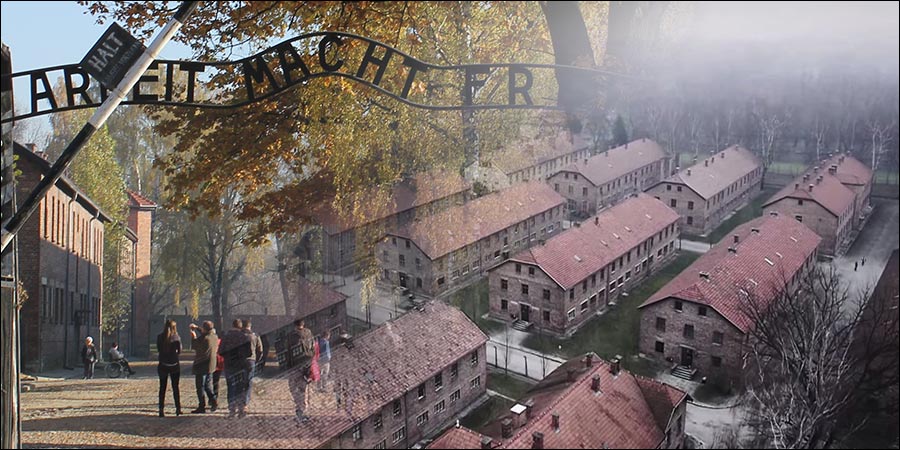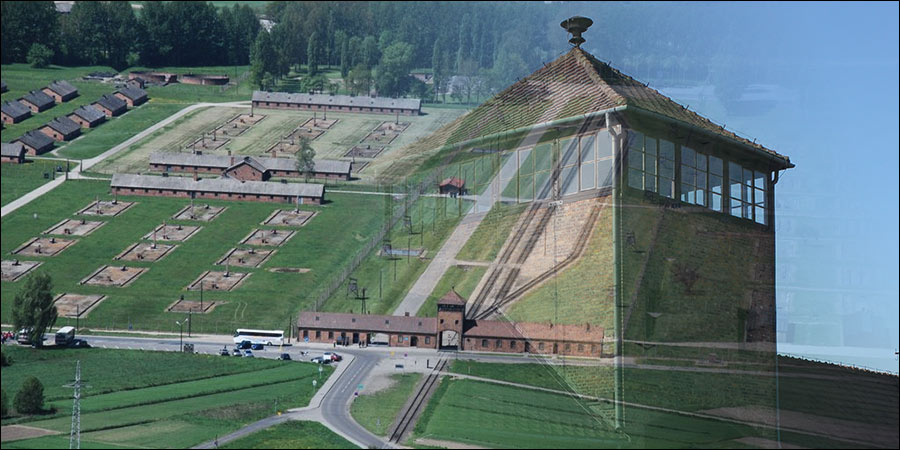Personal & group visit
We have an extensive experience in organizing individual tours for families and small groups. Such a visit must be prearranged and our offer includes: transportation (Mercedes Viano, Vito), courier, tour in Auschwitz-Birkenau performed by licensed Auschwitz educator (study tour).
We arrange visits in Auschwitz for organized groups. Our offer includes: transportation (Couch, Mercedes Sprinter), courier, tour in Auschwitz-Birkenau performed by licensed Auschwitz educator (study tour).
Contact us:
Holocaust Memorial Partnership
info@memorialpartnership.pl or
jerzy.wojcik@memorialpartnership.pl
Auschwitz- Birkenau.

|
The price is set individually Please contact us to discuss details of your visit: info@memorialpartnership.pl or phone: +48 572-303-388 |
Mission statement
A visit to Auschwitz is for many people a very emotional experience. One of our priorities is to make every effort to ensure that each visit runs in a harmonious way and becomes a form of commemoration. Because Auschwitz is a lesson for all of us—the lesson that even democratic systems, under certain circumstances, can turn toward authoritarian rule, and that even the most civilized societies can turn towards brutal and populist solutions. As Edmund Burke said, "The only thing necessary for the triumph of evil is for good men to do nothing." In the current situation, in which Europe enters the era of rising nationalism, the lesson from Auschwitz should be very explicit and visible.
Auschwitz-Birkenau Memorial: why a Premium visit ?
Virtually all the companies on the market offer the basic service of a 3.5 hour sightseeing tour. We are the only company offering a 4-5 hour study tour, which allows an in-depth and comprehensive visit at the memorial. In addition, we are the only company run by certified guides and Educators of the Auschwitz-Birkenau State Museum. Our offer is addressed to clients with greater expectations, who appreciate an individual approach and professional services. Read more about us >>>
(Auschwitz-Birkenau as a state museum offers a variety of tours including 1-2 days educational programs. Please visit: www.auschwitz.org)
//////////////////////////////////////////////
Auschwitz I


Władysław Bartoszewski - prisoner of Auschwitz, Minister of Foreign Affairs of Poland (1920-2014)
"Then for the last time I saw Nowak - a doctor who saved my life in Krankenbau (then transferred to Majdanek, died of typhus). "Doctor, not for nothing you strained then, I'm alive" - I said. "Well, then how you live, you know what you have to do." "I do not know what to do" - I was surprised. "Remember: to know.”.

Henryk Mandelbaum - Member of sonderkommando (1922-2010)
"… I saw the workers dragging corpses, somewhere else they were shaving hair, pulling out teeth. Smoke and fire. I remembered my mother's words. She said if I were not a good man I would end up in hell. Exactly this hell I saw. But I realised I would not be a hero in this place and I have to do what they say otherwise I would end up in a furnace...”.
Visiting Auschwitz I - the Museum

Auschwitz I has got a large number of exhibition buildings. The main exhibition includes blocks nos. 4, 5, 6, 7, and 11. In addition, there are so-called national exhibitions: block no. 13—The Destruction of the European Roma; block no. 14— Russian exhibition: Tragedy. Valour. Liberation; block no. 15— The Struggle and Martyrdom of the Polish Nation 1939‒1945; block no. 16—The Tragedy of the Slovakian Jews, and Prisoners from the Czech Lands in Auschwitz Concentration Camp; block no. 18—The Citizen Betrayed: A Remembrance of Holocaust Victims from Hungary; block no. 20—Deportees from France to Auschwitz Concentration Camp: March 27, 1942‒January 27, 1945, and Belgium 1940‒1945: The Occupation and Deportation to Auschwitz Concentration Camp; block no. 21—The Persecution and Deportation of Jews from The Netherlands in the Years 1940—1945; block no. 27—Shoah. National exhibitions are extremely rich in factual information and comprehensively present the history of nations or of the Jewish population in each country during the war. We would like to include two national exhibitions in the tour: block 18—the Hungarian exhibition and block 27—the Jewish exhibition. The last building, which also is one of the most important elements of the grounds of the former Auschwitz I camp, is the building of the gas chamber and crematorium no. 1.
Our Premium visit includes:
Block no. 3—the authentic conditions of the prisoners. Since the liberation of the camp, the interior of the blocks has been preserved almost intact. It comprises rooms for prisoners, a washroom, toilets and other areas, furnished with original strawbeds, bunks and other elements of block furnishing.
Block no. 4—the main exhibition on the extermination of European Jews. We are here to get information on the selection process and to see the original photos taken by the Nazis themselves, and found after the war by Lili Jacob-Meyer. In addition, we can find there a model of the gas chamber and crematorium no. 2, as well as the victims’ hair.
Block no. 5—a place of reflection and contemplation. Visitors have an opportunity to see original items found by Soviet soldiers when the camp was liberated: the personal belongings brought by the Jews—eyeglasses, suitcases, shoes, brushes, and other things.
Block no. 11—the camp prison. The place of the brutal interrogations and tortures carried out by the Nazis on the political prisoners. Visitors may also see the basement including number of cells used for punishments and tortures.
Block no. 27—Yad Vashem exhibition (previously so called the Jewish Block). This is the most recent exhibition—it was opened in 2013. It shows Jewish life in prewar Europe, the Nazi ideology, and the extermination of Jews in Nazi-occupied Europe. The exhibition also includes testimonies of survivors and artistic sketches made by children during the war, and recreated there by an Israeli artist. The last element of the exhibitionis the “Book of Names” with the names of the victims of the Holocaust collected by the Yad Vashem Institute.
The gas chamber and crematorium no. 1—the first place of mass extermination of Jews in Auschwitz-Birkenau. The crematorium operated until the summer of 1943. The estimated number of corpses cremated there is about 70 thousand.
Certainly we are in a position to have time for additional expositions, but these would be visited individually by our guests.
//////////////////////////////////////////////
Auschwitz II - Birkenau


Wilhelm Brasse (1917-2012) - prisoner of Auschwitz
"I felt my kommando was extraordinary and working in the atelier was, given the camp conditions, a dream job. I worked in peace, without anyone lurking behind my back... Here, firstly, I was working in my profession, and secondly, I was in a heated, safe space. Nobody raised their voices. We had underwear, clothes, shoes, coats.”

Zofia Posmysz (1923-...) - prisoner of Auschwitz
"So what that I realy did not know anyhthing about him? Neither his profession nor which town or city he was from? Whether he was married or free? This thought actually did not cross my mind even for a moment. He was there. He existed. He existed in my life. A good spirit, light in the darkness of Birkenau. Incomprehensible happiness, indescribable... I was happy. There. In Auschwitz”.
Visiting Auschwitz II - Birkenau

Birkenau was quite different from Auschwitz I. It is a huge—175-hectare—area, largely kept in its original state. This place does not have traditional museum exhibitions like the first part. However, Birkenau is the site where 90% of the Auschwitz-Birkenau extermination center victims were murdered. The visit in Birkenau consists of walking around in order to see the authentic places where the Nazis carried out the selection and extermination of Jews. It includes wooden barracks, selection place, and the ruins of gas chamber and crematoria no. 2, 3 or 4, 5. The whole visit to Auschwitz-Birkenau takes about 4‒5 hours. Visitors usually spend 2 h‒2.20 h at the former Auschwitz I, and after a short break of 30‒40 minutes, the visit is continued in Birkenau, which usually takes about 1,5 hours. The time needed for the visit, transfer from and back to Krakow included, is about 8 hours.
 Jude rampe - platform of the selection of the Jews.
Jude rampe - platform of the selection of the Jews.
 Wooden baracks for prisoners
Wooden baracks for prisoners
 Ruins of the gas chamber and the crematorium no. 2
Ruins of the gas chamber and the crematorium no. 2
 Ruins of the gas chamber and the crematorium no. 3
Ruins of the gas chamber and the crematorium no. 3
 Ruins of the gas chamber and the crematorium no. 4
Ruins of the gas chamber and the crematorium no. 4
 Ruins of the gas chamber and the crematorium no. 5
Ruins of the gas chamber and the crematorium no. 5











